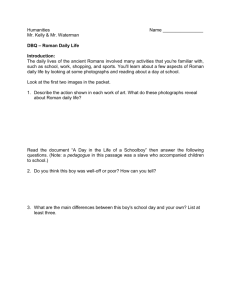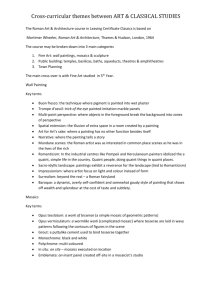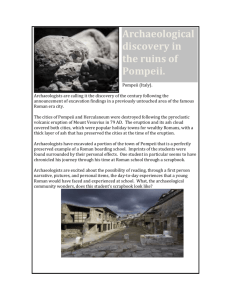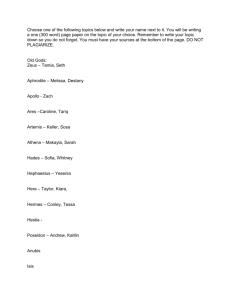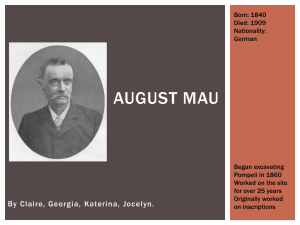Augustus 07 Lecture XIX
advertisement
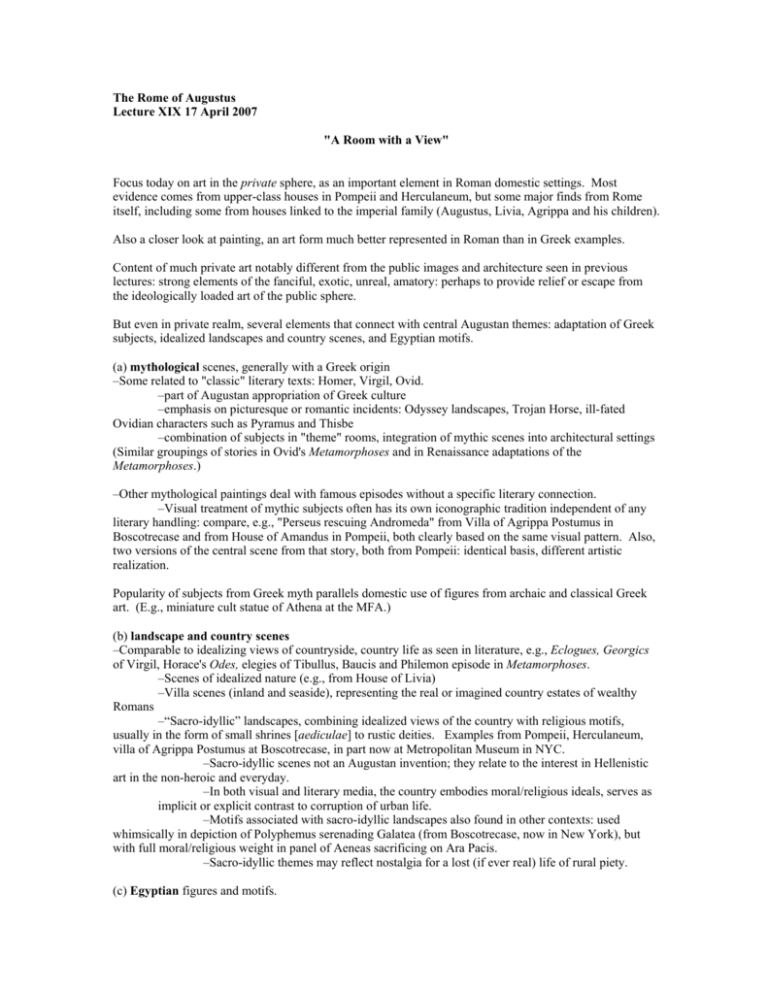
The Rome of Augustus Lecture XIX 17 April 2007 "A Room with a View" Focus today on art in the private sphere, as an important element in Roman domestic settings. Most evidence comes from upper-class houses in Pompeii and Herculaneum, but some major finds from Rome itself, including some from houses linked to the imperial family (Augustus, Livia, Agrippa and his children). Also a closer look at painting, an art form much better represented in Roman than in Greek examples. Content of much private art notably different from the public images and architecture seen in previous lectures: strong elements of the fanciful, exotic, unreal, amatory: perhaps to provide relief or escape from the ideologically loaded art of the public sphere. But even in private realm, several elements that connect with central Augustan themes: adaptation of Greek subjects, idealized landscapes and country scenes, and Egyptian motifs. (a) mythological scenes, generally with a Greek origin –Some related to "classic" literary texts: Homer, Virgil, Ovid. –part of Augustan appropriation of Greek culture –emphasis on picturesque or romantic incidents: Odyssey landscapes, Trojan Horse, ill-fated Ovidian characters such as Pyramus and Thisbe –combination of subjects in "theme" rooms, integration of mythic scenes into architectural settings (Similar groupings of stories in Ovid's Metamorphoses and in Renaissance adaptations of the Metamorphoses.) –Other mythological paintings deal with famous episodes without a specific literary connection. –Visual treatment of mythic subjects often has its own iconographic tradition independent of any literary handling: compare, e.g., "Perseus rescuing Andromeda" from Villa of Agrippa Postumus in Boscotrecase and from House of Amandus in Pompeii, both clearly based on the same visual pattern. Also, two versions of the central scene from that story, both from Pompeii: identical basis, different artistic realization. Popularity of subjects from Greek myth parallels domestic use of figures from archaic and classical Greek art. (E.g., miniature cult statue of Athena at the MFA.) (b) landscape and country scenes –Comparable to idealizing views of countryside, country life as seen in literature, e.g., Eclogues, Georgics of Virgil, Horace's Odes, elegies of Tibullus, Baucis and Philemon episode in Metamorphoses. –Scenes of idealized nature (e.g., from House of Livia) –Villa scenes (inland and seaside), representing the real or imagined country estates of wealthy Romans –“Sacro-idyllic” landscapes, combining idealized views of the country with religious motifs, usually in the form of small shrines [aediculae] to rustic deities. Examples from Pompeii, Herculaneum, villa of Agrippa Postumus at Boscotrecase, in part now at Metropolitan Museum in NYC. –Sacro-idyllic scenes not an Augustan invention; they relate to the interest in Hellenistic art in the non-heroic and everyday. –In both visual and literary media, the country embodies moral/religious ideals, serves as implicit or explicit contrast to corruption of urban life. –Motifs associated with sacro-idyllic landscapes also found in other contexts: used whimsically in depiction of Polyphemus serenading Galatea (from Boscotrecase, now in New York), but with full moral/religious weight in panel of Aeneas sacrificing on Ara Pacis. –Sacro-idyllic themes may reflect nostalgia for a lost (if ever real) life of rural piety. (c) Egyptian figures and motifs. –Egyptian animals in “Nilotic” scenes (e.g., camel from House of Livia) –Egyptian religious imagery as a decorative element (Boscotrecase). Partly a way of advertising the addition of Egypt to Roman sphere (compare post-Actium coins with crocodiles and hippos, or the display of obelisks in Rome), partly an interest in the foreign as "other." But also suggestive of Rome’s being infiltrated by the culture it had defeated. Further reading: General: Roger Ling, Roman Painting (Cambridge 1991) Elaine Gazda (ed.), Roman Art in the Domestic Sphere (Ann Arbor 1991) On cycles of paintings on related subjects: Richard Brilliant, Visual Narratives: Storytelling in Etruscan and Roman Art (Ithaca: Cornell UP 1984), chap. 2; Bettina Bergmann, "The Roman House as Memory Theater: The House of the Tragic Poet in Pompeii," The Art Bulletin 76 (1994) 225-256. Reading for Lecture XX: Selections from the Elder Seneca (Sourcebook 208-211).
